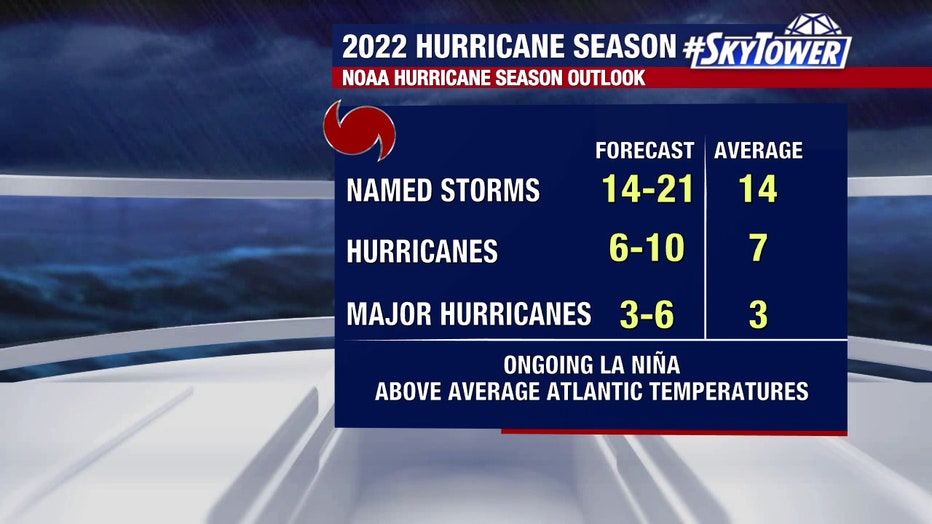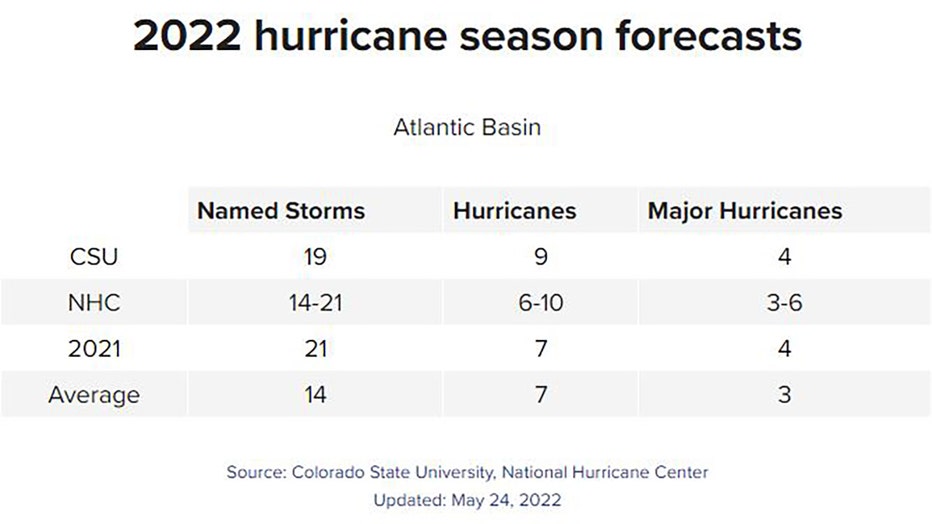NOAA forecasts above-average 2022 Atlantic hurricane season with up to 21 named storms
2022 Hurricane Season: NOAA once again predicts 'above average' season
With an ongoing La Niña, NOAA is predicting another busy Atlantic hurricane season for 2022.
MIAMI - A little more than a week away from the start of the Atlantic hurricane season, the National Oceanic and Atmospheric Administration released its outlook for the 2022 season, predicting an above-average number of named storms.
Forecasters from NOAA's Climate Prediction Center are predicting 14 to 21 named storms, 6 to 10 hurricanes and 3 to 6 major hurricanes (Category 3 or higher on the Saffir-Simpson Hurricane Wind Scale). These numbers are greater than the 30-year averages (1991-2020) of 14 named storms, seven hurricanes and three major hurricanes.
This marks the 7th consecutive above-average season, NOAA administrator Rick Spinrad said.

FOX Weather Meteorologist Mike Rawlins explains the increased activity this season is tied to the ongoing La Niña that will continue through the hurricane season.
"In the Atlantic, warmer than average temperatures in the water here usually means more storms," Rawlins said.
ATLANTIC HURRICANE SEASON HAS STARTED EARLY FOR 7 CONSECUTIVE YEARS
Warmer-than-average sea surface temperatures in the Atlantic and the Caribbean Sea, as well as an enhanced west African monsoon also factored into the NOAA prediction.
"The forecast bottom line is that there are increasing odds that we are going to see a much busier than average season," Rawlins said.
FOX Weather Meteorologist Ian Oliver said the outlook is a reminder to prepare because it's too early to tell where storms will make landfall.
"Although this outlook suggests a lot of tropical activity, seasonal outlooks don't forecast where these storms could eventually strike or how many landfalls could occur," Oliver said. "Preparing for potential tropical impacts now (including getting your supplies and your plan in place) can prevent a lot of stress later. We'll keep you updated on anything brewing in the tropics all season on FOX Weather!"
CLEANER AIR LEADS TO MORE HURRICANES IN THE ATLANTIC, STUDY FINDS
NOAA and FEMA leaders revealed the forecast at the New York City Emergency Management Department during a news conference on Tuesday.
Rewatch the NOAA announcement below:
Before NOAA's hurricane forecast, Colorado State University released its initial 2022 Atlantic hurricane season outlook last month, predicting another above-average season with 19 named storms, including nine hurricanes and four major hurricanes.
THE HISTORY OF THE CSU ATLANTIC HURRICANE FORECAST
Below is a look at the National Hurricane Center and CSU outlooks compared to last season and the 30-year average.

(Fox Weather)
The 2021 Atlantic hurricane season was the third most active on record, producing 21 named storms and seven hurricanes, four of which became Category 3 or stronger.
Last week, NOAA's Central Pacific Hurricane Center and Climate Prediction Center released an outlook for the Central Pacific hurricane season. NOAA predicts a below-average season for that region, with two to four named storms expected for the entire season. A near-average season would include four to five storms.
PIVOTAL FACTORS OF UPCOMING 2022 HURRICANE SEASON EXPLAINED
Ahead of the official start of the Atlantic hurricane season, the NHC denoted its first area of interest last weekend for a disorganized cluster of thunderstorms in the Gulf of Mexico. However, the system dubbed Invest 90L fizzled out after moving inland over the southeastern U.S.
Every year since 2015, the Atlantic hurricane season has started early, with the NHC tracking one or more storms in the tropics at least a few weeks before the official start.
Most recently in this seven-year stretch of early starts, Tropical Storm Ana briefly roamed the central Atlantic Ocean last year between May 22 and 23. It developed east of Bermuda but quickly moved northeastward away from the archipelago and out to sea.
Study finds cleaner air leads to more hurricanes
Cleaner air in the United States and Europe is brewing more Atlantic hurricanes, a new U.S. government study found.
Ana briefly produced gale-force winds over portions of Bermuda, but no other impacts were reported on land from this short-lived storm.
According to the NHC, there is nothing currently being monitored in the Atlantic Basin, which includes the Atlantic Ocean, the Gulf of Mexico and the Caribbean Sea.
The Atlantic hurricane season begins June 1 and ends Nov. 30. The list of 21 names being used this season begins with Alex and ends with Walter.
NOAA will update its outlook again in early August, ahead of peak hurricane season.
This six-month period was chosen by the NHC because it accounts for 97% of all Atlantic tropical storms and hurricanes, according to NOAA’s Hurricane Research Division.
That means only 3% of Atlantic tropical cyclones occur outside those dates, with the majority of out-of-season activity occurring in May or December. However, there has been either an Atlantic tropical storm or hurricane in every month of the year, as can be seen in the graph below.
Read updates at FOXWeather.com.

